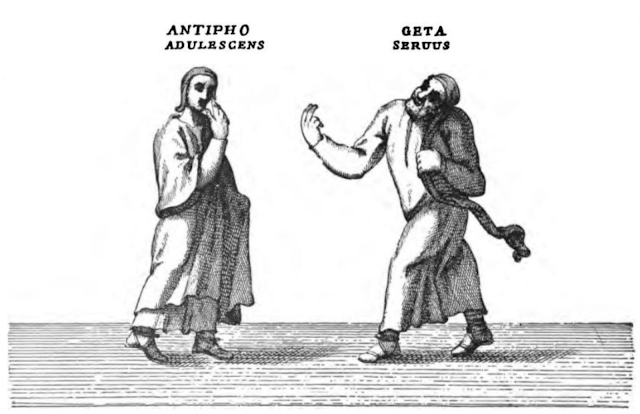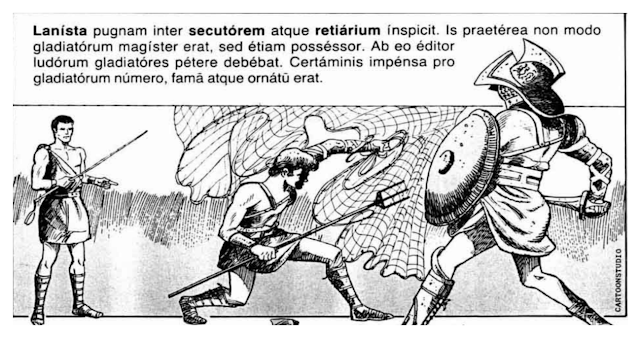is a reading comprehension test for Latin with a variety of passages ranging from historical narratives to modern articles. Scores are measured on a range from N1-5 to A with I1-5 in between. You can see a sample score report
. The Language Testing International Organization has released a practice exam, available
. This practice exam is based on the structure of the official sample test, providing those interested with unofficial materials to study with. The questions generally increase in difficulty as you move through the texts and are taken from a wide range of sources. Currently, there is no way to assess the level of each question, but generally the first questions are equivalent to novice levels and the final questions are equivalent to the intermediate levels. Good Luck!
 |
Source: The Phormio of Terence
|
What relationship is portrayed here?
A.) Father - Son
B.) Young Man - Slave
C.) Old Man - Slave
D.) Merchant - Consumer
“Postquam Romani expulerunt Tarquinium helium habuerunt. Tarquinius enim Etruscus fuit. Ergo Etrusci venerunt ad bellum cum Romanis.”
Source: Latin by the Natural Method, William G. Most
Why did the Etruscan’s wage war with the Romans?
A.) Glory, Land and Honor
B.) Tarquinius became King of the Romans
C.) The Romans expelled Tarquinius
D.) The Romans rebelled from colonial rule.
 |
| Source: Lingua Latīna Per Sē Illūstrāta Pars I: Familia Rōmāna |
Which of these is a interiectio?
A.) Towards the castle
B.) Alas!
C.) Bob goes to the store
D.) Running through the hills
 |
| Source: Latin Wikipedia |
To what position was Zoran Milanovic elected to?
A.) Prime Minister of Croatia
B.) Chief of Interpol
C.) President of Croatia
D.) He was not elected to any position.
Who owns the gladiators?
A.) The Lanista
B.) The Magister
C.) The Editor
D.) The Fame
“Philosophiae servias oportet, ut tibi contingat vera libertas. Haec sunt uerba Senecae, octaua epistola ad Lucillum: quia uocari philosophiam scientiam ueritatis recte se habet ex secundometaphysicae, et philosophia affert delectationes mirabiles firmitate et puritate, ex decimo Ethicorum.” - Thomas Aquinas, XPOSITIO IN BOETHII DE CONSOLATIONE PHILOSOPHIAE
Who said the words: “You must engage in philosophy to find true freedom”?
A.) Aquinas
B.) Seneca
C.) Lucillus
D.) Ethicorus
“Multos dies Titus in lecto iacebat. Primo convalescere videbatur; mox tamen fiebat infirmior, nam in febrem subito inciderat. In dies morbus ingravescebat”
What is happening to Titus?
A.) He is getting wealthier
B.) His illness is getting worse
C.) His fortunes are decreasing
D.) His chairs are getting less comfortable
 |
| Source: De Rerum Natura, Selected Passages |
Hieronymus writes that Titus Lucretius killed himself in the year
A.) 66
B.) 46
C.) 44
D.) 64
Tum Mānlius ōrātor animōs populī ita cōnfīrmāvit:—“Magnam calamitātem accēpimus. Oppida nostra ā Cimbrīs Teutonibusque capiuntur, agricolae interficiuntur, agrī vāstantur, cōpiae barbarōrum Rōmae adpropinquant. Itaque, nisi novīs animīs proelium novum faciēmus et Germānōs ex patriā nostrā sine morā agēmus, erit nūlla salūs fēminīs nostrīs līberīsque. Servāte līberōs! Servāte patriam! Anteā superātī sumus quia imperātōrēs nostrī fuērunt īnfīrmī. Nunc Marius, clārus imperātor, quī iam multās aliās victōriās reportāvit, legiōnēs dūcet et animōs nostrōs terrōre Cimbricō līberāre mātūrābit.”
Source: Latin for Beginners by Benjamin L. D'Ooge
Who does the speaker recommend as a savior for the republic?
A.) Manlius
B.) The King
C.) The People
D.) Marius
“Postridie corpus Titi summo honore elatum est. Praecedebant tibicines, tubicines, cornicines. In pompa erant viri taedas tenentes, mulieres nenias cantantes, actores imagines et vestimenta maiorum gerentes, mimi, lictores, fasces ferentes, familiares, amici plorantes. “
What was not present during the event?
A.) Grieving Family Members
B.) Actors in his likeness
C.) Mimes
D.) Political Figures
“Sed prior effigiem tribuit successus aënam, // oraque patricius nostra dicavit honos; // adnuit hic princeps titulum poscente senatu; // respice iudicium quam grave, Musa, subis! // ingenio minuit merces properata favorem: // carminibus veniam praemia tanta negant; // et magis intento studium censore laborat, // quod legimur medio conspicimurque foro.” - Claudian, De Bello Gothico
What is described in the passage?
A.) The consequences of a great honor being bestowed upon the poet
B.) The debates of the great fathers on the expediency of the Gothic Wars
C.) A religious ceremony involving prayer to the Muses before a battle scene
D.) The challenges present within the life of a lower-class Roman citizen
Answer Key (place your cursor over the text to highlight/reveal the key): 1.) B 2.) C 3.) B 4.) C 5.) A 6.) B 7.) B 8.) C 9.) D 10.) D 11.) A












